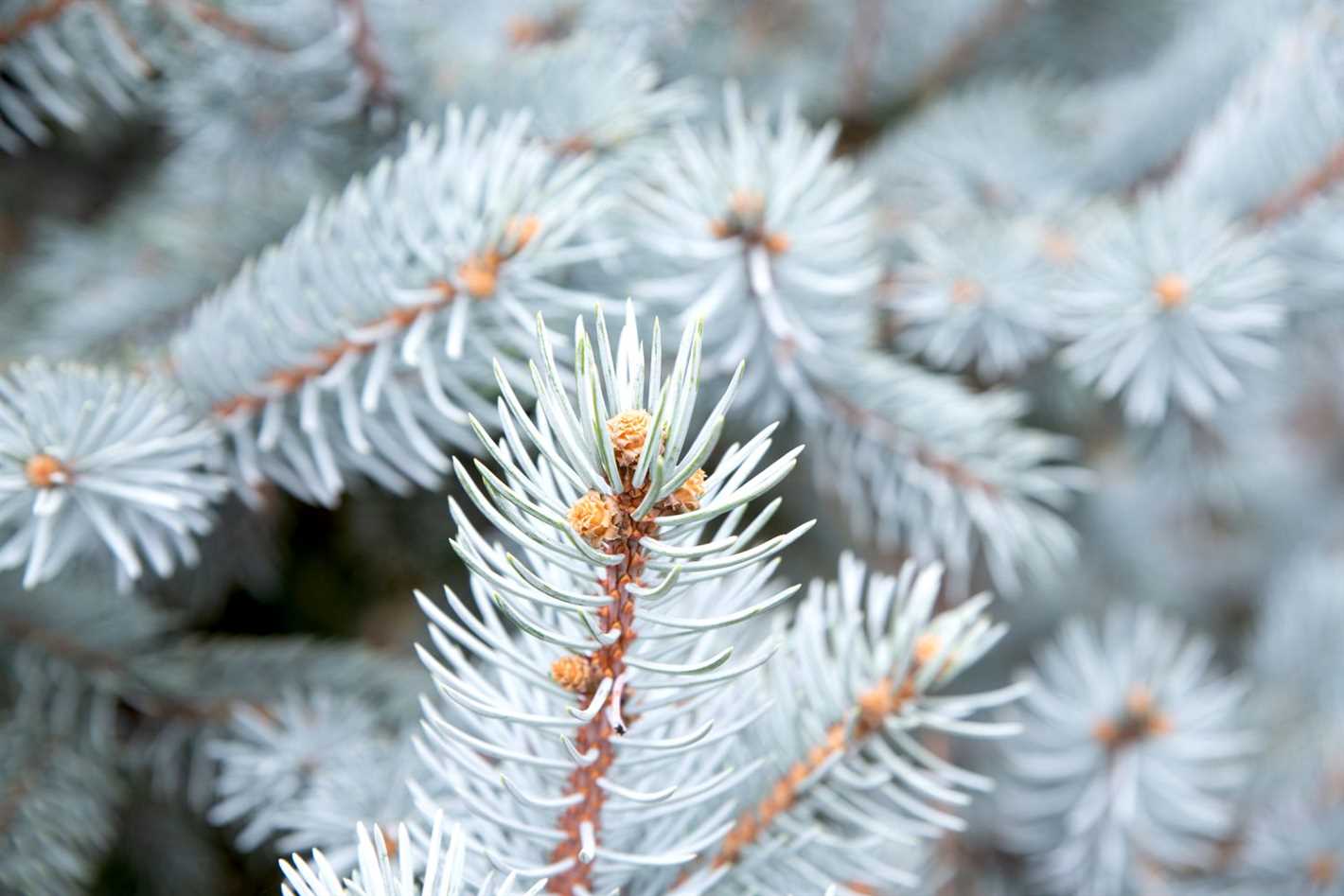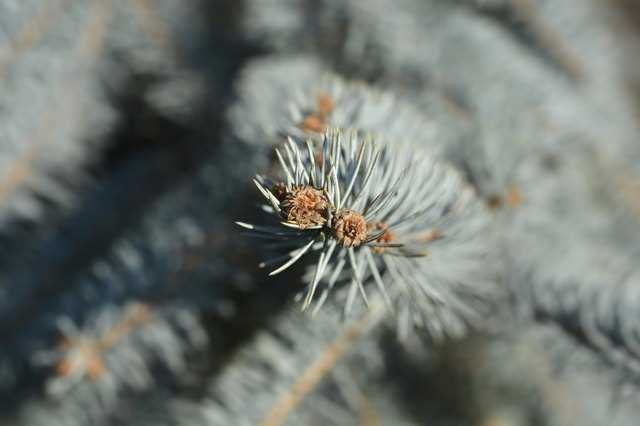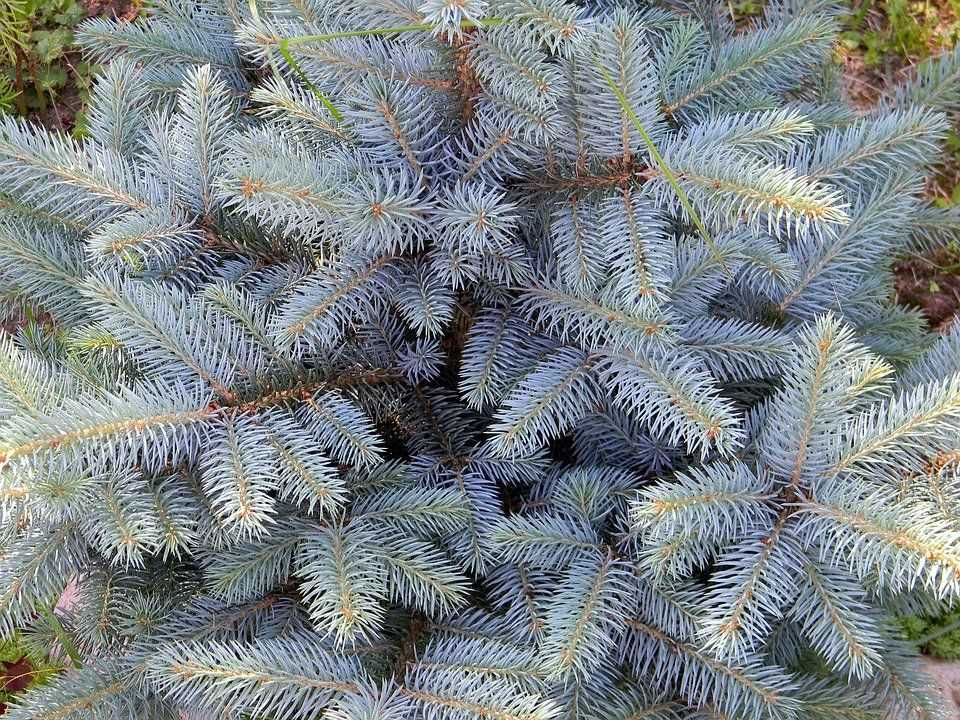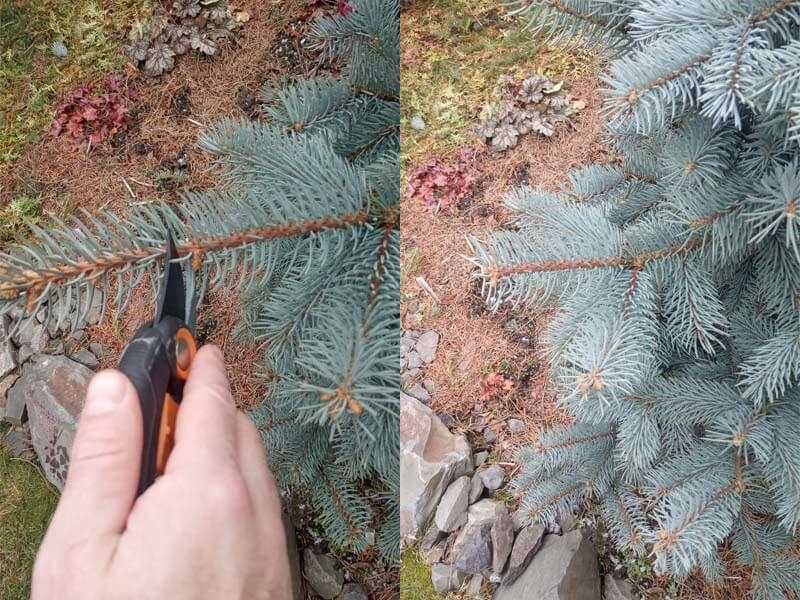- Choosing the Right Time
- 1. Season:
- 2. Weather Conditions:
- 3. Moisture Levels:
- 4. Tree Health:
- Selecting Healthy Cuttings
- Preparing the Cuttings
- Applying Rooting Hormone
- Steps to Apply Rooting Hormone:
- Planting the Cuttings
- Caring for the Cuttings
- Transplanting the Rooted Cuttings
- 1. Prepare the Transplant Pots
- 2. Carefully Remove the Rooted Cuttings
- 3. Plant the Cuttings in the Transplant Pots
- 4. Water the Transplanted Cuttings
- 5. Provide Proper Care
- 6. Monitor and Maintain
- Questions and Answers:
- What is the best time to propagate blue spruce cuttings?
- Can blue spruce cuttings be propagated in winter?
- What should I do before taking blue spruce cuttings?
- How long should blue spruce cuttings be?
- What type of rooting hormone should I use for blue spruce cuttings?
- How long does it take for blue spruce cuttings to root?
- Videos: How To Root Tree Cuttings

Blue spruce trees, with their striking blue-green foliage and elegant conical shape, are a popular choice for landscaping and garden enthusiasts. Whether you want to expand your collection of blue spruces or simply want to create new trees from existing ones, propagating blue spruce cuttings can be an exciting and rewarding project.
Propagation through cuttings is a cost-effective and efficient method to reproduce blue spruce trees with desirable traits. This step-by-step guide will walk you through the process of successfully propagating blue spruce cuttings, ensuring guaranteed success in growing new trees.
Step 1: Selecting the Right Time and Tools
Timing is crucial when it comes to propagating blue spruce cuttings. The best time to take cuttings is during late spring or early summer when the new growth is still soft and pliable. Tools needed for the propagation process include a sharp, sterile knife or pruners, a clean container for water, and rooting hormone powder.
Step 2: Choosing Healthy Parent Trees
Choose healthy parent trees with desirable traits, such as strong growth, vibrant color, and overall good health. Select branches that are at least 4 inches long and have a diameter of about a pencil. Avoid branches that show signs of disease, damage, or excessive stress.
Step 3: Taking the Cuttings
Using the sharp knife or pruners, take cuttings from the selected branches just below a leaf node. Remove any lower leaves, leaving only a few at the top. Dip the cut end in rooting hormone powder to promote root development.
Step 4: Preparing the Cuttings
Place the cuttings in a clean container filled with water, making sure that at least one or two leaf nodes are submerged. Keep the container in a cool, shaded area to prevent wilting. Change the water every few days to ensure freshness and prevent the growth of bacteria.
Step 5: Rooting the Cuttings
After about 4-6 weeks, the cuttings should start developing roots. Check the cuttings regularly to monitor their progress. Once the roots are about 2 inches long, it’s time to plant them in a suitable potting mix.
Remember to provide the new plants with adequate moisture, light, and protection from extreme temperatures to ensure their healthy growth. With proper care and attention, your newly propagated blue spruce cuttings will soon grow into beautiful, thriving trees that will enhance your landscape for years to come.
Choosing the Right Time


When it comes to propagating blue spruce cuttings, timing is crucial. Choosing the right time to take cuttings will greatly increase your chances of success. Follow these guidelines to ensure the best results:
1. Season:
The best time to take blue spruce cuttings is during the dormant season, which usually falls between late fall and early spring. This is when the tree is not actively growing and is more responsive to propagation.
2. Weather Conditions:


Avoid taking cuttings during periods of extreme heat or cold. It is best to choose a time when the weather is mild, with temperatures ranging from 45 to 65 degrees Fahrenheit (7 to 18 degrees Celsius).
3. Moisture Levels:


Choose a time when the soil moisture levels are optimal. Cuttings should be taken when the soil is slightly moist, but not overly saturated. This will provide the ideal conditions for root development.
4. Tree Health:
Inspect the blue spruce tree before taking cuttings. Choose a healthy and disease-free tree for propagating cuttings. Look for signs of yellowing leaves, pest infestations, or any other potential issues that could affect the success of the cuttings.
By choosing the right time to take blue spruce cuttings, you are setting yourself up for success. Remember to consider the season, weather conditions, moisture levels, and tree health to maximize your chances of propagating healthy and thriving blue spruce trees.
Selecting Healthy Cuttings
- When propagating blue spruce cuttings, it is important to select healthy and disease-free plant material. Look for cuttings that have vibrant green needles and a strong, sturdy stem.
- Avoid selecting cuttings that have yellow or brown needles, as this could indicate an unhealthy or stressed plant.
- Choose cuttings that are around 4 to 6 inches in length, as this is the optimal size for propagation.
- It is also recommended to take cuttings from the previous year’s growth, as these are more likely to root successfully.
Once you have chosen your healthy cuttings, it is time to prepare them for propagation.
Preparing the Cuttings
Before you start propagating blue spruce cuttings, it’s essential to prepare them properly to increase their chances of success. Here is a step-by-step guide on how to prepare the cuttings:
- Select Healthy Branches: Choose healthy branches from a mature blue spruce tree. Look for branches that are about six to eight inches long and have a diameter of around 0.25 to 0.5 inches.
- Cut the Branches: Use clean and sharp pruning shears to make a clean, angled cut just below a leaf node. Remove any side shoots or lateral branches from the cutting.
- Remove Lower Needles: Carefully remove the lower 1/3 to 1/2 of the needles from each cutting. This will help reduce water loss and focus the plant’s energy on root development.
- Apply Rooting Hormone: Dip the bottom end of each cutting into a rooting hormone powder to encourage root growth. Follow the instructions on the rooting hormone product for the correct application technique.
- Moisten the Cuttings: Lightly moisten the cuttings by misting them with water. Avoid saturating the cuttings, as excessive moisture can lead to rotting.
- Prepare a Propagation Tray: Fill a propagation tray with a well-draining, sterile rooting medium, such as a mixture of peat moss and perlite. Make sure the tray has drainage holes to prevent waterlogging.
- Plant the Cuttings: Make small holes in the rooting medium using a pencil or your finger. Insert the prepared cuttings into the holes, ensuring that at least two leaf nodes are partially buried in the rooting medium.
- Mist and Cover: Mist the cuttings with water to provide moisture and cover the propagation tray with a clear plastic dome or plastic wrap to create a humid environment. This will help retain moisture and promote root development.
Following these steps will help ensure that your blue spruce cuttings are properly prepared for successful propagation. Remember to check on the cuttings regularly and provide them with the necessary care and attention during the rooting process.
Applying Rooting Hormone


Applying rooting hormone is an important step in the process of propagating blue spruce cuttings. Rooting hormone contains auxins, which are plant hormones that stimulate root growth. By applying rooting hormone to the cuttings, you can increase the chances of successful root development.
Steps to Apply Rooting Hormone:


- Prepare the rooting hormone according to the instructions on the package. Different products may have different instructions, so it’s important to follow them carefully.
- Take your blue spruce cuttings and make sure they are clean and healthy. Remove any leaves from the lower portion of the cutting to expose the stem.
- Dip the bottom inch or two of the cutting into the prepared rooting hormone. Make sure the end is completely covered with the hormone.
- Tap the cutting lightly to remove any excess hormone. Be careful not to remove too much, as it is important for the hormone to come into contact with the stem.
- Place the treated cutting into a pot or tray filled with moistened rooting medium. Gently press the soil around the cutting to ensure good contact with the hormone and the medium.
- Repeat the process with each cutting, making sure to keep track of which cutting is which, especially if you are using different varieties or cultivars.
Note: It’s important to handle the rooting hormone with care, as it may be toxic or irritating to the skin, eyes, or respiratory system. Follow the instructions on the package and take necessary precautions, such as wearing gloves and avoiding inhaling the product.
Using rooting hormone can significantly increase the chances of successful root development in blue spruce cuttings. It provides the extra boost that the cuttings need to produce healthy roots and establish themselves as new plants. However, it’s worth noting that while rooting hormone can improve success rates, it is not a guarantee. Other factors such as the quality of the cuttings, environmental conditions, and proper care also play important roles in the overall success of the propagation process.
Planting the Cuttings
After preparing your blue spruce cuttings, it is time to plant them in a suitable growing medium. Follow these steps to ensure successful propagation of your blue spruce cuttings:
- Choose a well-draining pot or container that is at least 4 inches deep. Make sure it has drainage holes at the bottom to prevent waterlogging.
- Fill the container with a well-balanced potting mix or a mixture of perlite and peat moss. This will provide the necessary nutrients and moisture retention for the cuttings.
- Create holes in the potting mix about 2 inches apart using a pencil or your finger. The holes should be deep enough to accommodate the bottom third of the blue spruce cuttings.
- Dip the bottom end of each cutting into a rooting hormone powder to promote root growth. Gently shake off any excess powder.
- Place the cuttings into the prepared holes, making sure they are upright and not touching each other. Press the potting mix gently around the base of the cuttings to secure them in place.
- Moisten the potting mix evenly using a spray bottle or by pouring water into the container. Avoid oversaturating the soil, as this can lead to rotting.
- Cover the container with a clear plastic bag or place it in a propagator to create a greenhouse-like environment. This will help retain humidity and promote root development.
- Keep the container in a warm location with indirect sunlight, such as a windowsill away from direct heat sources. Maintain the temperature between 60-70°F (15-21°C) for optimal rooting.
- Mist the cuttings with water regularly to keep the humidity levels high. Avoid overwatering, as this can cause fungal diseases.
- Monitor the cuttings regularly for signs of growth, such as new shoots or roots. This process can take several weeks to several months depending on the conditions and the variety of blue spruce.
- Once the cuttings have established a strong root system, you can transplant them into individual pots or directly into the garden. Gradually acclimate them to outdoor conditions before transplanting, and provide proper care to ensure their growth and survival.
Following these steps will increase your chances of successfully propagating blue spruce cuttings and adding these beautiful evergreens to your garden or landscape. Happy planting!
Caring for the Cuttings
After successfully propagating the blue spruce cuttings, it is important to provide them with proper care in order to ensure their growth and survival. Here are some essential steps to follow:
- Watering: Blue spruce cuttings require regular watering to keep the soil moist, but not waterlogged. Watering should be done consistently, especially during the first few weeks after propagation. It is important to monitor the moisture level of the soil and adjust the watering frequency accordingly.
- Lighting: Blue spruce cuttings need ample sunlight to thrive, so it is important to place them in a location where they can receive at least 6 hours of direct sunlight each day. If growing indoors, using fluorescent or LED grow lights can provide the necessary light intensity.
- Temperature: Blue spruce cuttings prefer cool to moderate temperatures. Keep them in a location where the temperature is between 60 to 70°F (15 to 21°C). Avoid extreme heat or cold, as it can stress the cuttings.
- Humidity: Blue spruce cuttings prefer a slightly higher humidity level. To increase humidity, you can use a plastic bag or a propagation dome to create a mini greenhouse effect. This will help retain moisture around the cuttings.
- Fertilizing: During the first year of growth, it is not necessary to fertilize the blue spruce cuttings. They will obtain sufficient nutrients from the soil. However, if you notice poor growth or yellowing leaves, you can apply a balanced slow-release fertilizer specifically formulated for evergreen trees.
- Protection: Blue spruce cuttings are delicate and susceptible to damage from harsh winds, heavy rain, or pests. It is important to protect them from these elements by providing wind barriers or using a light shade cloth. Regularly inspect the cuttings for any signs of pests or diseases and take appropriate measures to prevent or treat them.
By providing proper care and following these steps, your blue spruce cuttings will have the best chance of growing and thriving. Remember to be patient and give them time to establish roots before transplanting them to their final growing location.
Transplanting the Rooted Cuttings
Once your blue spruce cuttings have successfully rooted, it’s time to transplant them into a suitable growing medium. Following these steps will ensure a smooth and successful transplantation process:
1. Prepare the Transplant Pots


Choose pots that are at least 6 inches deep and have drainage holes at the bottom. Fill the pots with a well-draining potting mix that is suitable for growing blue spruce trees.
2. Carefully Remove the Rooted Cuttings
Gently remove the rooted cuttings from the propagation medium by carefully loosening the soil around the roots with your fingers. Be cautious not to damage the delicate root system.
3. Plant the Cuttings in the Transplant Pots


Make a small hole in the center of each pot and place a rooted cutting into it. Spread the roots out evenly and cover them with the potting mix, ensuring that the cutting is securely held in place. Firmly press the potting mix around the base of the cutting to provide stability.
4. Water the Transplanted Cuttings


After planting the cuttings, thoroughly water the pots until water drains out the bottom. This will help settle the potting mix around the roots and provide the necessary moisture for the newly transplanted cuttings.
5. Provide Proper Care
Place the transplanted cuttings in a location that receives bright, indirect sunlight. Keep the soil evenly moist, but not overly saturated, by watering the pots when the top inch of soil feels dry. Avoid overwatering, as it can lead to root rot.
6. Monitor and Maintain
Regularly monitor the transplanted cuttings for any signs of stress or disease. Prune away any dead or diseased foliage and continue to provide the necessary care, such as regular watering and fertilizing, to promote healthy growth.
Following these steps will ensure a successful transplantation of your blue spruce cuttings. With proper care and maintenance, you can enjoy watching them grow into beautiful blue spruce trees.
Questions and Answers:
What is the best time to propagate blue spruce cuttings?
The best time to propagate blue spruce cuttings is in late spring or early summer.
Can blue spruce cuttings be propagated in winter?
No, it is not recommended to propagate blue spruce cuttings in winter as the plant is dormant and the success rate is much lower.
What should I do before taking blue spruce cuttings?
Before taking blue spruce cuttings, you should prepare a rooting medium, gather all the necessary tools, and choose healthy branches to cut from the tree.
How long should blue spruce cuttings be?
Blue spruce cuttings should be about 4 to 6 inches long for optimum success.
What type of rooting hormone should I use for blue spruce cuttings?
You should use a rooting hormone powder or gel specifically formulated for woody plants.
How long does it take for blue spruce cuttings to root?
It usually takes about 6 to 8 weeks for blue spruce cuttings to root. However, it can vary depending on environmental conditions.







